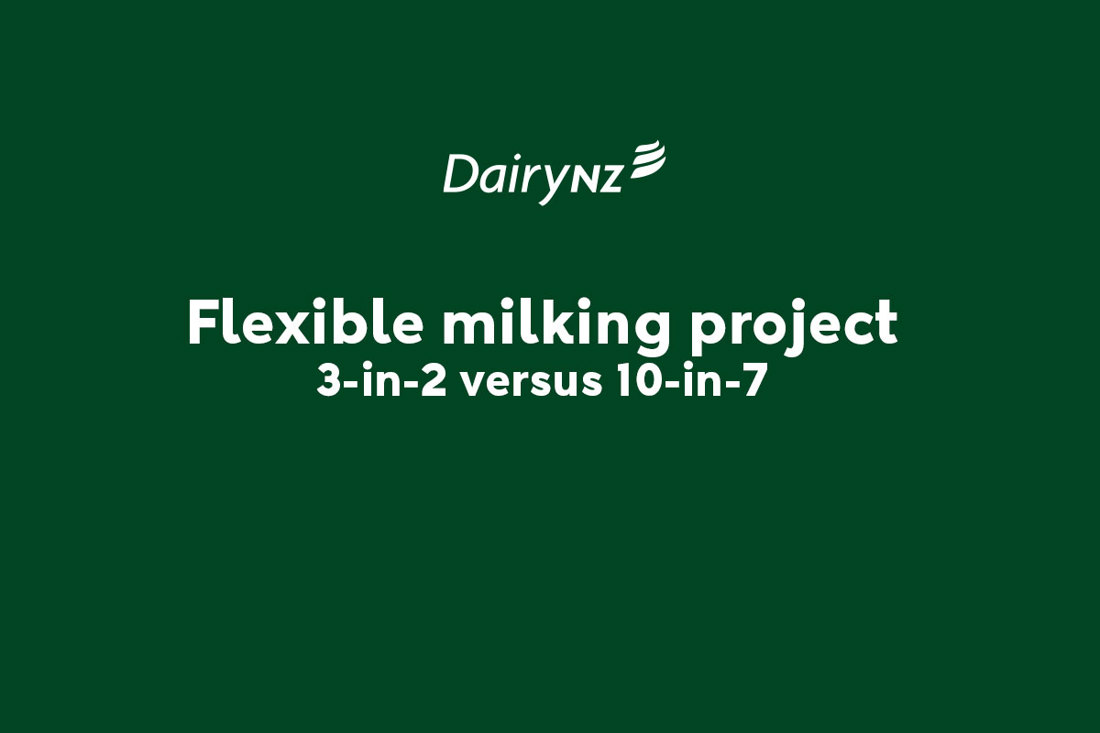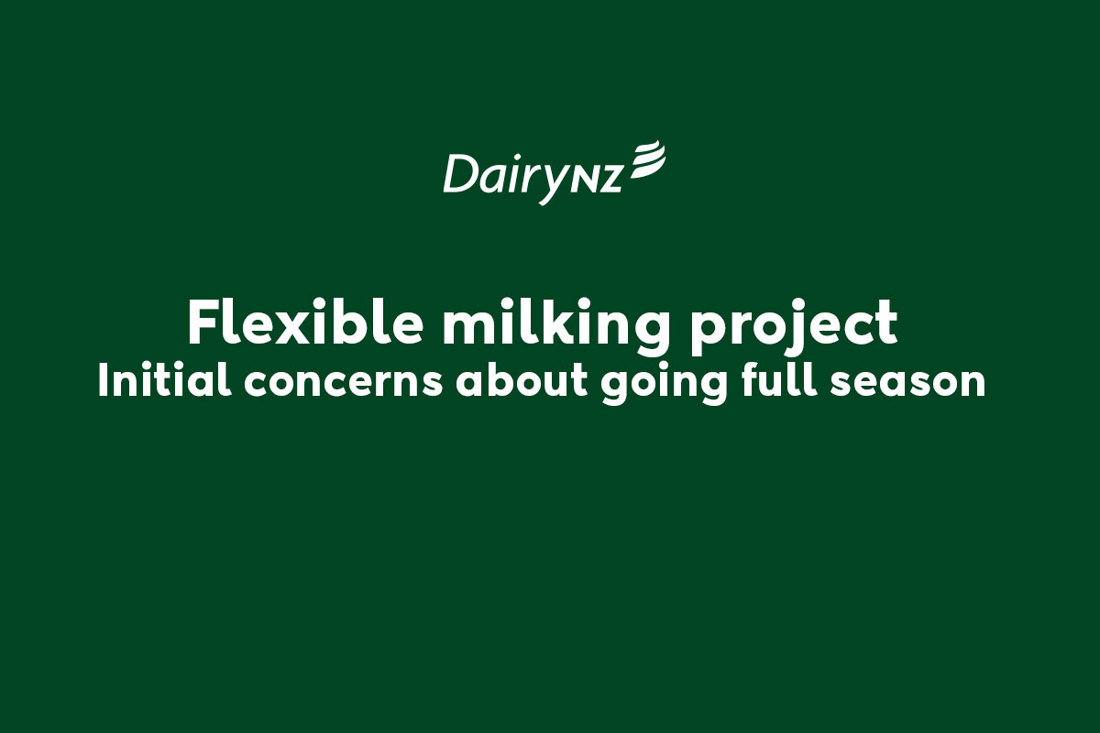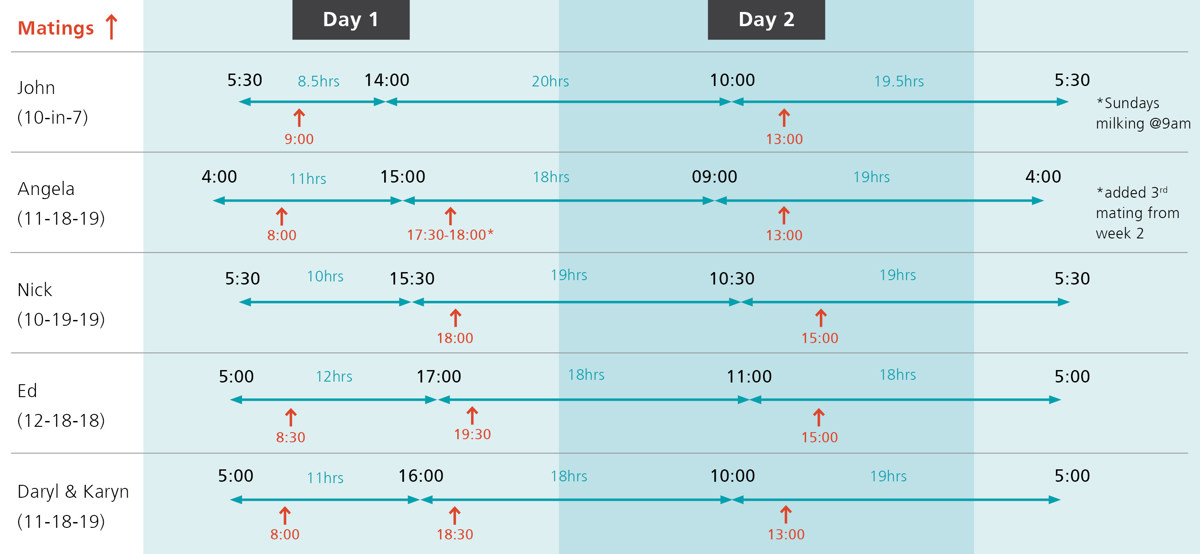Flexible Milking
6 min read
Flexible milking is a term for milking practices that fall between the traditional once-a-day (OAD) or twice-a-day (TAD) milking. This page explores various forms of flexible milking, such as milking three times in two days (3-in-2) and ten milkings in seven days (10-in-7), and the reasons for implementing these strategies on your farm. It includes insights from pilot farms that have used flexible milking, outlining both benefits, like improved staff wellbeing and cow health, and challenges, such as grazing and pasture management. Information on economic and production results is also provided to demonstrate the feasibility and impact of flexible milking.
Flexible milking is a ‘catch-all’ term given to milking intervals that sit between more traditional once-a-day (OAD) or twice-a-day (TAD) milking.
It refers to flexibility in both the timing of the milking during the day, as well as the number of milkings in a week. The most common forms of flexible milking are milking three times in two days (3-in-2) and ten milkings in seven days (10-in-7).
Reasons for implementing 3-in-2 milking on your farm will be specific to your circumstances, so understanding your goals and assessing whether flexible milking will help you achieve them is key to success.
"Using 3-in-2 during mid-late lactation gives us flexibility with rosters, and allows me to give staff leave over summer without needing extra cover"
"Choosing 10-in-7 means we are only milking our 400 cows OAD over the weekends, which we and our staff love!"
"It has a positive effect on BCS especially when the herd is on long walks late in lactation"
"The benefit of a sleep in every second day is large"
"This is our second season going 10-in-7. Staff love it, cows love it, I love it."

Video 0:55 min
| Benefits | ||
| For people | For animals | For lifestyle |
| Staff attraction and retention | Body condition | Flexibility |
| Better work hours | Lameness | Family time |
| More flexibility | Overall cow health | Wellbeing |
| Improved reproductive performance from carry-over effects | Time to recover and refresh from a sleep-in every other day | |
| Less hot afternoon milkings |
| Challenges |
| Getting grazing and pasture management correct. |
| Choosing the right schedule/times for the whole team. |
Tauranga farmer Nick Dowson and his manager Rick share what they were concerned about and what gave them the confidence to try full season.

Production and profit impacts are a key driver behind the decisions you make on farm. The Pilot farmers (see Additional resources) around New Zealand have demonstrated how economical flexible milking can be, as demonstrated by the snapshot of John Totty’s results below.
Not everyone will be able to increase production as seen here, but many farms could operate using flexible milking without a substantial drop in profitability.
| OAD for 3 weeks at calving then TAD 2019/20 | OAD for 3 weeks at calving then 10-in-7 2020/21 | |
| Production | 377 kgMS/cow | 378 kgMS/cow |
| FWE | $4.90/kgMS | $4.69/kgMS |
| Profit/ha | $2,271/ha | $3,641/ha |
Different times suit different teams, so it’s important to work with the people on your farm to decide what flexible milking times to use. To give you an idea, you can see the times used by the pilot farmers in the image below. They didn’t all begin with the times displayed, they have adapted them over time to suit. More detailed information can be found on the implementing flexible milking page, see below Additional resources.

Some farmers have said that working out the grazing is the trickiest part and that it is easily overcomplicated.
There are two systems that farmers have recommended:
More information on grazing can be found on the Implement Flexible Milking, see below Additional resources.
Selecting when in the season to use flexible milking on your farm will come down to your motives, what outcomes you are trying to achieve, and the capability of your team to carry it out at the required stage of the season.
Farmers using flexible milking indicate that each year they have started using it earlier in the season, as they begin to see the advantages for both their people and cows, and little to no impact, or sometimes an increase, in production.
To explore potential trade-offs of using 3-in-2 at different times in the season, a DairyNZ farmlet study was conducted in 2019/20.
There were four herds:
There was a significant linear effect, implying that at any stage of lactation there was a cost to protein production (-8%) or benefit to BCS (6%), which was proportional to the duration of using 3-in-2.
An example of the different impacts that could be seen from using 3-in-2 at different times of the season:
| Protein kgMS/cow/year |
Fat kgMS/cow/year |
Body condition early May |
Total kgMS/cow/year |
|
| TAD | 196 kg | 248 kg | 4.4 | 444 |
| 3-in-2 from March 1 (Final 30% of season) | (-8%*30%) = -5 191 kg |
Not significantly different | (+6%*30%) = 4.48 |
439 |
| 3-in-2 from Dec 1 (Final 60% of season) | (-8%*60%) = - 9 187 kg |
Not significantly different | (+6%*60%) = 4.56 |
435 |
| 3-in-2 full season | -8% = - 16 180 kg |
Not significantly different | +6% = 4.66 |
428 |
Condition score benefits are likely to be better on a commercial farm than shown here as walking distances in the experiment were small in comparison.
More information on this study can be read here, including the effects on lameness and potential implications for profit.
However, a key point to note is that in a research environment an equal amount of time and effort went into managing each herd. In a commercial context, there is additional time (or less fatigue) due to fewer milkings that can be used to improve farm management, potentially improving production outcomes, as seen in the pilot farms we followed in 2020/21.
Five of these farmers implemented full season 3-in-2 milking, only one of them experienced a drop in herd milk production.
Figure 1 shows the production impact experienced by ~300 commercial herds that adopted OAD between 2008 and 2015. Their production for 4 years prior to changing to OAD milking, year 0 represents the first season of OAD and then the affects OAD milking had over the next 4 years is plotted.

The figure uses kg MS/cow which offers limited insight into the farm system changes that may also have occurred at the same time. However, it illustrates that it is easier to maintain production levels in lower producing herds. Conversely, it is likely harder to maintain profit with OAD in higher producing herds and/or farms with less ability to reduce costs. In these circumstances flexible milking may be a more appropriate strategy.
Research results and experiences of farmers using flexible milking strategies ranges from no decrease in production to ~-5% relative to TAD milking.
Find out about new milking frequency insights and regional trends, plus hear about the experiences of some farmers using once-a-day (OAD) milking in early lactation.
Flexible milking case study and research | Ep. 19
What prompted the Lincoln University Demonstration Dairy Farm’s move to full-season 10-in-7 milking? And what impact has it had on animal health, fertility, production and staff wellbeing? We speak with demonstration lead Jeremy Savage. Listen now
Better workplaces through flexible milking | Ep. 11
Could reducing the number of milkings in a week help the dairy sector attract new staff and improve work-life balance? One farmer who’s gone to a flexible milking schedule is John Totty in Canterbury. What were his reasons for changing his milking schedule, and what kind of outcomes is he seeing? Listen now
Now’s the perfect time to check in, plan, and set up for a strong season. We’ve pulled together smart tips and tools to help you stay ahead all winter long.
Whether you prefer to read, listen, or download handy guides, we’ve got you covered with trusted tools to support your journey every step of the way.
Put our proven strategies and seasonal tools to work. Boost production, support animal health and watch your profits hum.
Tools that are backed by science, shaped by farmers and made for this season.
That’s Summer Smarts.